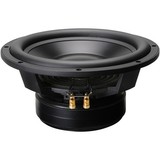DIY sub guide
Author: Paul Spencer

This is our quick guide to choosing the right parts for your DIY sub project. To keep things simple, we won't delve into the nitty gritty technical aspects like aluminium vs paper cones, inductance, BL linearity & motor design. Instead, we'll get you started in terms of choosing a driver that suits the box size you have in mind, and choosing an amp to go with it. We often get questions about a particular driver a customer is considering. We might have a customer asking about Datyton Ultimax 15" for a small box. We can tell them right away it's not the right choice, because Ultimax 15" is a large box sub driver.
Basic choices
First choose the basic parameters for your sub project.1. Sealed or ported
For a first DIY project and for most customers, we recommend a sealed box design with our SPA500 plate amplifier. These will sound best in most rooms and they are smaller in box size. If music listening is the major priority, you will probably choose a sealed design. Moving to a ported box will typically double the box volume requirements. The benefit is you get about twice the perceived output in the lowest octave or equal output down there to two sealed subs with the same driver and amp. In a music system, two sealed subs will double the perceived output over a single ported sub of the same size, where the extension is limited to about 40 Hz. This is why your priorities in listening are important to consider.
2. Do you want to get "technical?"
A ported sub is much more difficult to design. You need to model the design, realising that free software most will use is typically inaccurate, resulting in the need to test the tuning with an impedance sweep. (Dayton DATS can be used for this purpose - a simple sweep will reveal the port tuning so you can adjust it). The aerodynamics of the port is also a key issue and will often bottleneck the gains you expected on paper with output. We recommend our circular flared ports so that you can cut to the right length. Some like to build slot ports but in a custom sub, this limits you to the tuning you modelled, which may turn out to be incorrect. Don't be surprised if your port ends up too long or too short!
3. How much output do you need?
It's difficult to come up with a definitive answer of how much SPL you want to achieve and how much you will actually get in your room. If your system is in a bedroom or study, you will probably find any of our 8" or 10" drivers in a sealed box will provide a compact solution. Moving into a small to medium living room, we suggest a step up to a 12" or 15" sealed box. In larger rooms we suggest 15" or 18" boxes and multiple subs which can also be used to smooth out the room response. Where bottom octave extension and output is important, box size is king. Believe it or not, a ported 15" is expected to out-gun a sealed box 18" driver! The larger driver wins above 40 Hz but below this region the larger box and port begin to take over. Of course, this will depend on many specific details, but as a general rule of thumb this will prove true.
Next: Introducing the drivers >
